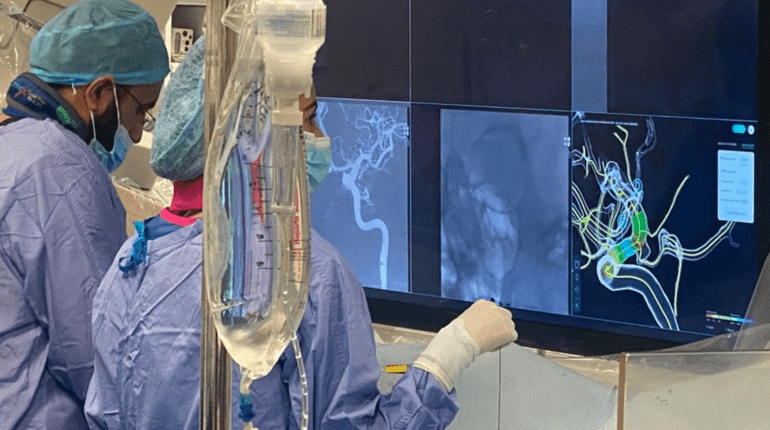TL;DR:
- PreSize, an AI-powered software platform, is revolutionizing brain aneurysm treatment.
- It offers more accurate stent placement than experienced neurosurgeons.
- Aneurysms are life-threatening, and stents divert blood flow to prevent ruptures.
- PreSize minimizes guesswork in stent placement, which is crucial for success.
- It creates digital twins to simulate stent behavior in the brain.
- PreSize has been used successfully in hundreds of patient operations.
- The National Institute for Health and Care Research (NIHR) recognizes its potential.
- Research indicates PreSize achieves a 95% accuracy rate, outperforming human clinicians.
- Further research and testing are needed before wider deployment.
Main AI News:
The landscape of brain aneurysm treatment is poised for a revolutionary transformation, thanks to a cutting-edge software platform infused with the power of artificial intelligence. Enter “PreSize,” a groundbreaking program that has demonstrated exceptional accuracy in the placement of stents, surpassing the capabilities of seasoned neurosurgeons.
Brain aneurysms, characterized by weak or thin spots on vessel walls that fill with blood, represent a formidable health concern due to their potential life-threatening ruptures. Stents, in this context, are mesh tubes designed to expand and divert blood flow, alleviating the risk of aneurysm rupture. The ultimate goal is for the blood to clot and naturally dissolve, restoring normalcy.
Traditionally, the placement of these stents has involved a considerable degree of uncertainty and guesswork. Dr. Katerina Spranger, the visionary founder of Oxford Heartbeat, the brains behind PreSize, acknowledges these challenges. Stents are meticulously guided into place through a catheter inserted in the groin, monitored by X-rays. Nevertheless, complications can arise. An undersized stent may detach and navigate the body’s circulatory system, while an oversized one could potentially rupture the vessel itself.
What sets PreSize apart is its ability to provide a precise image of the patient’s brain and create digital counterparts, known as “digital twins,” that simulate the behavior of a real stent within the brain. This simulation enables predictions regarding the outcome when a specific device is introduced at a particular location. In the operating theater, PreSize becomes a valuable tool for neurosurgeons, allowing them to experiment with various stents to determine the optimal choice. Dr. Spranger underscores the critical role precision plays in these delicate procedures, where a mere fraction of a millimeter can spell the difference between success and failure.
PreSize’s impact is already making waves in the medical community. Over 375 patients have undergone successful procedures utilizing this technology, spanning seven hospitals in England and Scotland, with additional cases in Germany, Finland, and Ukraine. The National Institute for Health and Care Research (NIHR) recognizes the immense potential of AI technologies to accelerate diagnosis and treatment, thereby improving patient outcomes. NIHR is actively funding a multitude of AI projects, including the collaboration with the NHS AI Lab, to gather the evidence necessary for wider implementation across the healthcare system.
Initial research findings suggest a significant advantage in favor of PreSize. A study published in the BMJ Journal of Neurointerventional Surgery revealed that PreSize outperformed human clinicians in predicting the landing position of stents within the brain. Human clinicians achieved an average accuracy rate of 81%, while PreSize demonstrated an impressive 95% accuracy.
Dr. Spranger emphasizes the need for further research and rigorous testing before contemplating the broader deployment of AI in healthcare. While AI holds the potential to revolutionize the medical field, meticulous evaluation and accountability remain paramount to address any lingering concerns and build trust in this transformative technology.
Conclusion:
The emergence of PreSize represents a significant advancement in the treatment of brain aneurysms. Its superior accuracy and potential to improve patient outcomes make it a game-changer in the medical field. This innovation has the potential to drive market growth in AI-driven healthcare solutions and reshape the future of aneurysm treatment.

